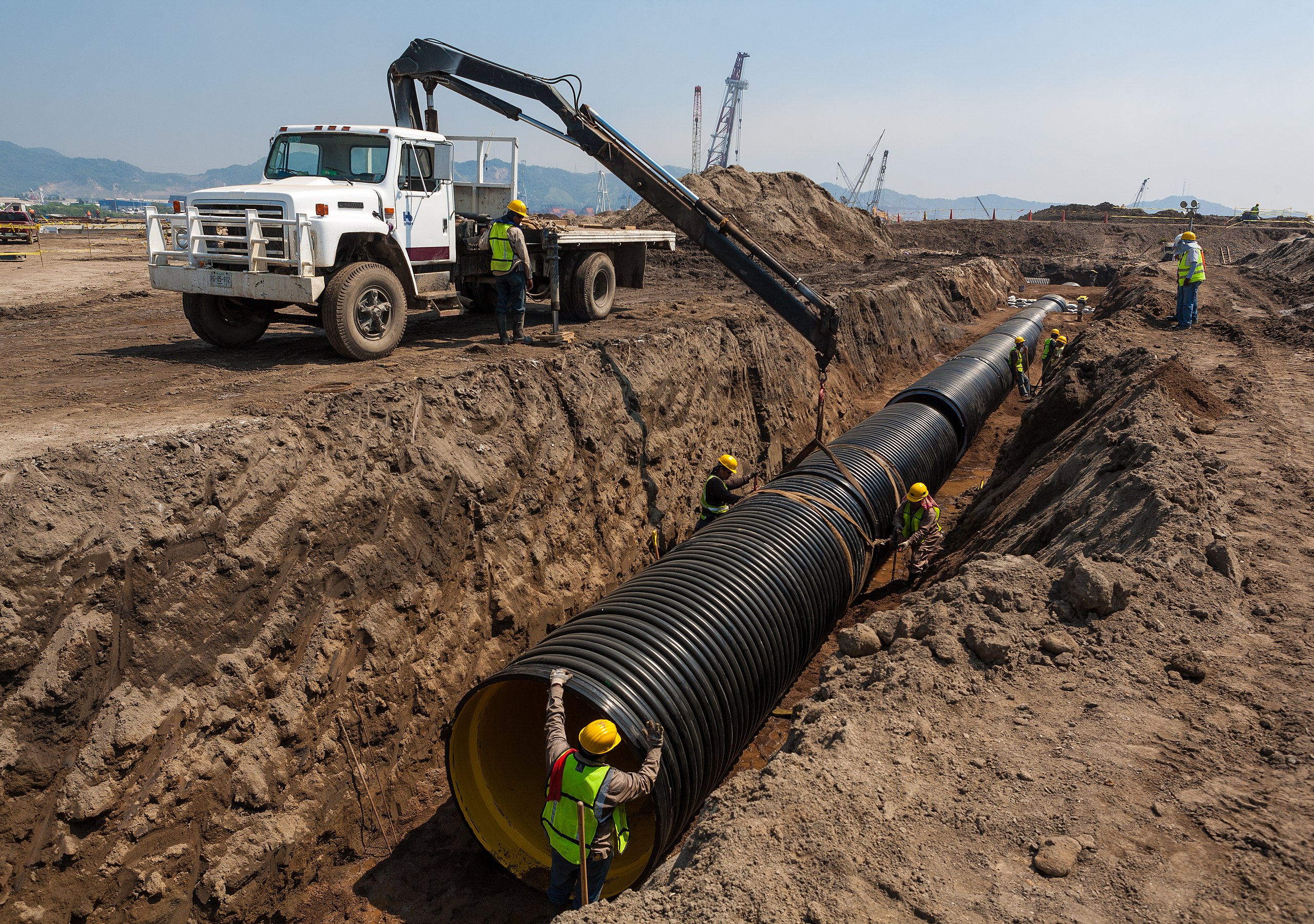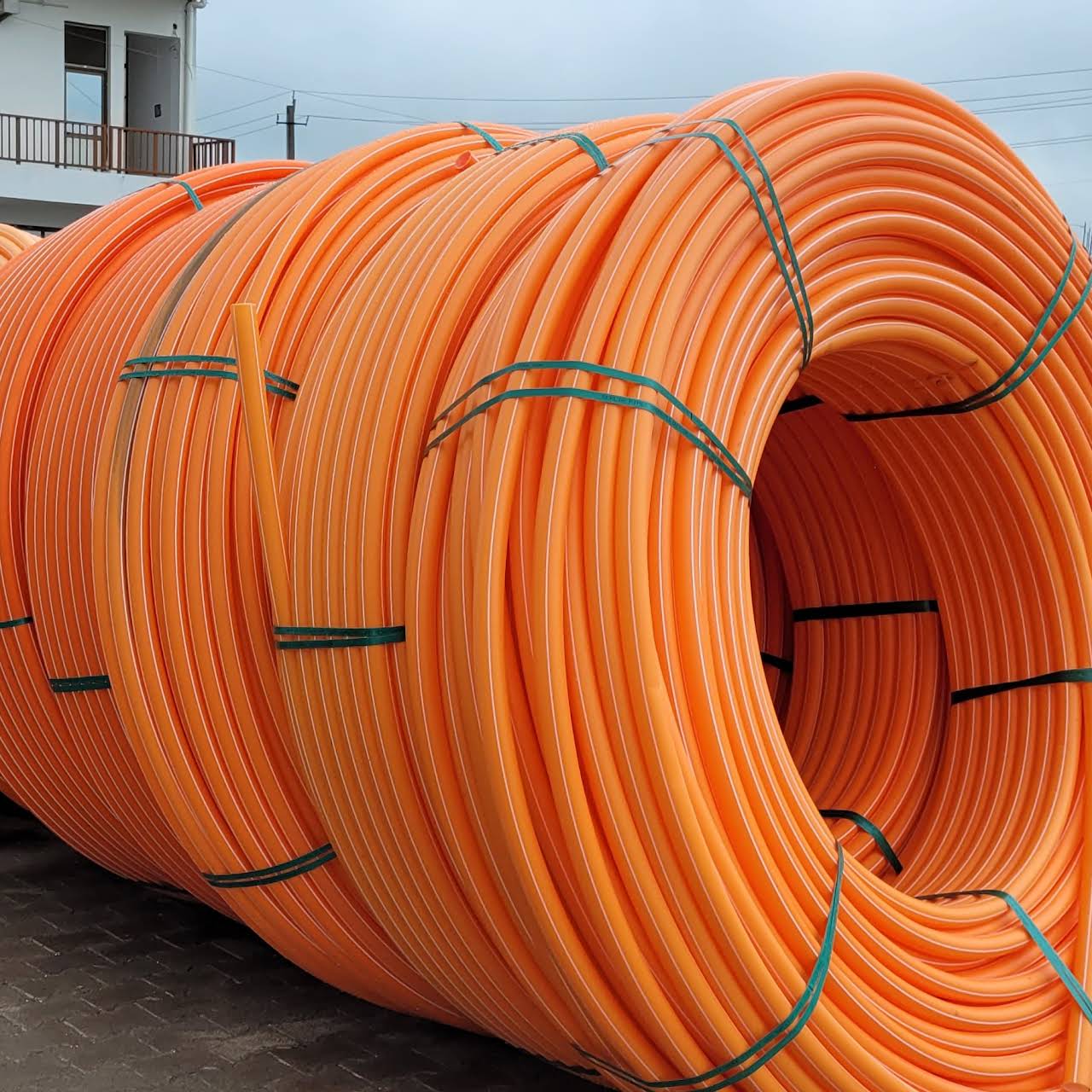Discover the Manufacturing Refine Behind High-Quality HDPE Pipeline and Its Applications
The manufacturing procedure of premium HDPE pipelines is complex and systematic. It begins with the choice of raw products that boost performance. Following this, ethylene undertakes polymerization to develop material, which is after that shaped via extrusion. Quality assurance is vital, making certain that the last product fulfills strict criteria. Nonetheless, the journey of HDPE pipelines doesn't finish with production. Their applications across various markets disclose a wider significance worth examining.
Recognizing HDPE: Features and Advantages

High-density polyethylene (HDPE) is a functional thermoplastic understood for its resilience and resistance to different ecological elements. This material shows exceptional tensile toughness, making it appropriate for requiring applications. Its low-density framework adds to a light-weight item, promoting convenience of managing and installment. HDPE also showcases impressive resistance to chemicals, which lessens destruction when exposed to harsh materials.
The product's reduced wetness absorption better boosts its durability, making it excellent for use in pipelines and storage space tanks. Additionally, HDPE is resistant to ultraviolet (UV) radiation, guaranteeing that items keep their integrity even when exposed to sunlight. Additionally, its versatility allows for the development of elaborate forms without endangering toughness. The green nature of HDPE, typically originated from recycled materials, contributes to its allure, advertising lasting methods in production. Generally, these residential or commercial properties and advantages make HDPE a preferred option for different industrial and consumer applications.
Resources Choice for HDPE Manufacturing
The option of raw products for HDPE manufacturing is important to verify the end product fulfills the desired requirements and top quality requirements. High-density polyethylene (HDPE) is largely generated from polymerized ethylene, derived from fossil fuels such as gas or petroleum. The quality of these feedstocks significantly influences the mechanical and thermal residential properties of the final HDPE.
Ingredients also play a significant role in boosting HDPE's efficiency, consisting of antioxidants, UV stabilizers, and colorants, which improve durability and resistance to ecological factors. The choice procedure must consider not just the chemical composition of the raw materials yet additionally their processing features to ensure reliable manufacturing.
The sourcing of raw materials must prioritize sustainability and compliance with ecological regulations, as accountable practices are necessary in today's market. Ultimately, cautious resources choice lays the foundation for producing top notch HDPE pipelines suitable for diverse applications.
The Extrusion Process: Shaping HDPE Pipeline
The extrusion procedure plays a vital function fit HDPE pipes, starting with meticulous material preparation techniques that ensure excellent flow and consistency. Similarly crucial is the layout of the die, which directly influences the final dimensions and surface quality of the pipeline. With each other, these factors contribute significantly to the performance and top quality of HDPE pipeline manufacturing.
Product Preparation Strategies
Reliable manufacturing of HDPE pipelines begins with precise product prep work methods, especially the extrusion procedure. Throughout this stage, high-density polyethylene material is very first dried out to remove wetness, making certain ideal circulation qualities. The material is then fed into the extruder, where it undertakes home heating and melting, changing into a thick state. This heating process is meticulously regulated to preserve the material's honesty and efficiency. The liquified HDPE is forced through a die, forming it into a continuous pipeline type. Proper temperature level monitoring during extrusion is essential, as it directly impacts the product's buildings and the last product top quality. As soon as formed, the HDPE pipe is cooled down and cut to defined sizes, all set for subsequent handling and applications.
Die Style Significance
Accuracy in die style plays a necessary function in the extrusion process of HDPE pipelines. The die functions as the final shaping device, directly affecting the pipe's dimensions, wall surface thickness, and surface area finish. A well-designed die warranties uniform product flow, lowering problems such as irregularities and vulnerable points. The geometry of the die have to be enhanced to fit the details residential properties of HDPE, including its thickness and thermal habits during extrusion. In addition, the cooling price of the product as it travels through the die can markedly affect the pipe's architectural stability. Spending in innovative die innovation is vital for suppliers intending to create premium HDPE pipes that meet market criteria and client expectations.
Quality Assurance Steps in HDPE Production
Although various elements influence the top quality of HDPE pipe manufacturing, effective quality assurance measures are essential to assure consistency and dependability in the end product. Key quality assurance practices consist of extensive material evaluation, confirming that the raw polyethylene meets established standards for pureness and density. Throughout the extrusion process, parameters such as temperature level, stress, and cooling time are closely monitored to maintain dimensional precision and architectural integrity
In addition, post-production screening is essential; manufacturers usually conduct hydrostatic tests to assess the pipeline's strength and resistance to pressure. Aesthetic examinations for surface defects better improve quality control. Qualification from relevant criteria organizations, like ASTM or ISO, supplies an additional layer of reliability. By executing these thorough quality assurance measures, producers can reduce problems, enhance efficiency, and guarantee that the HDPE pipelines fulfill the specific requirements of various applications, eventually bring about client fulfillment and rely on the product.
Applications of HDPE Pipeline Across Industries
HDPE pipelines are utilized throughout numerous industries because of their sturdiness and flexibility. In water distribution systems, they ensure efficient shipment, while in wastewater administration, they supply trusted remedies for waste transport. Furthermore, farming watering networks profit from HDPE's resistance to corrosion and flexibility, making it a perfect choice for contemporary farming practices.

Water Distribution Equipments
A substantial variety of industries rely upon high-density polyethylene (HDPE) pipelines for efficient water distribution systems. Understood for their longevity and resistance go to my site to corrosion, HDPE pipelines are widely utilized in municipal water supply networks, farming irrigation, and commercial applications. Their lightweight nature promotes very easy handling and installment, minimizing labor prices and time. Additionally, HDPE pipes can fit various pressure degrees, making them ideal for both low and high-pressure systems. Pipe Manufacturing Midland TX. The versatility of the material enables seamless combination right into existing infrastructure, lessening the demand for comprehensive excavation. Additionally, HDPE's resistance to chemical seeping warranties that the water delivered stays risk-free and tidy, making it a suitable selection for preserving the high quality of safe and clean water across different markets
Wastewater Administration Solutions
Effective water circulation systems likewise lead the method for innovative wastewater monitoring options, where high-density polyethylene (HDPE) pipelines play a considerable role. Renowned for their durability and resistance to corrosion, HDPE pipes are suitable for transporting wastewater in various setups. Their versatility enables simple setup in complicated environments, decreasing the requirement for comprehensive excavation. In addition, HDPE's smooth indoor surface lowers friction, boosting flow prices and effectiveness. These pipelines are likewise immune to chemical leaching, guaranteeing that contaminants do not endanger the surrounding environment. Industries, municipalities, and therapy centers progressively depend on HDPE pipelines for their reliability and durability, making them a recommended choice for modern wastewater monitoring systems. This versatility emphasizes the vital value of HDPE pipelines throughout many applications.
Agricultural Irrigation Networks
Agricultural watering networks benefit substantially from using high-density polyethylene (HDPE) pipelines, which offer effective and trustworthy water distribution to crops. HDPE pipelines are lightweight, making them easy to transport and set up, while their versatility enables for various setups in diverse surfaces. These pipelines show exceptional resistance to rust, chemicals, and UV radiation, making certain toughness in severe farming environments. Furthermore, their smooth indoor surface area decreases friction loss, enhancing water flow and minimizing power prices related to pumping. The durability of HDPE pipelines, often exceeding 50 years, contributes to lower maintenance and substitute expenditures. Farmers increasingly count on HDPE pipes to boost watering effectiveness and promote sustainable farming techniques, inevitably leading to boosted plant yields and resource preservation.

Future Fads in HDPE Pipe Innovation
As the need for lasting and efficient facilities expands, developments in HDPE pipe innovation are positioned to change numerous markets. Emerging patterns consist of the assimilation of clever modern technologies, such as sensing units and IoT capabilities, which help with real-time tracking of pipe problems, reducing maintenance expenses and protecting against leakages. In addition, the development of advanced manufacturing strategies, such as 3D printing, is making it possible for the manufacturing of complicated, customized pipe styles that provide to specific job requirements.
The emphasis on recycling and circular economic climate techniques is driving the technology of HDPE pipelines made from recycled products, improving sustainability. Enhanced jointing techniques, such as electro-fusion and mechanical fittings, are also boosting installment performance and integrity. Ultimately, the expanding focus on ecological guidelines is pushing manufacturers to take on greener production processes, guaranteeing that HDPE pipelines not only meet sector requirements but likewise foster an even more sustainable future for infrastructure advancement.
Often Asked Questions
Just How Does HDPE Contrast to Other Plastic Products?
HDPE outmatches lots of various other plastic materials regarding resilience, chemical resistance, and adaptability. Its low thickness and high tensile strength make it excellent for various applications, frequently going beyond alternatives in both efficiency and longevity.
What Are the Environmental Influences of HDPE Production?
The ecological influences of HDPE production consist of greenhouse gas discharges, energy intake, and potential air pollution from manufacturing processes. In addition, incorrect disposal can bring about soil and water contamination, elevating issues concerning long-term ecological effects.
Can HDPE Pipeline Be Reused?
Yes, HDPE pipes can be reused. Several dig this centers accept utilized HDPE for processing, changing it into new products. This reusing adds to sustainability efforts, decreasing plastic waste while saving sources and power in the production cycle.
What Is the Lifespan of HDPE Water Lines?

Just How Do Temperature Variations Impact HDPE Pipeline Performance?
Temperature level variants considerably impact HDPE pipeline efficiency, affecting adaptability and strength. Heats can cause softening, while reduced temperature levels might create brittleness, ultimately affecting the pipeline's resilience and suitability for various applications in diverse settings.